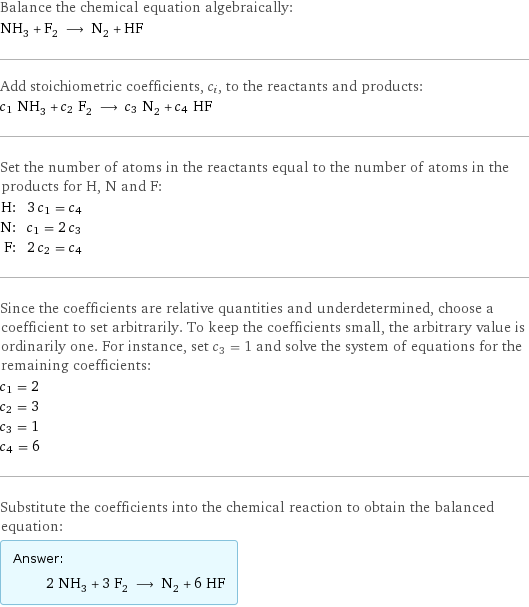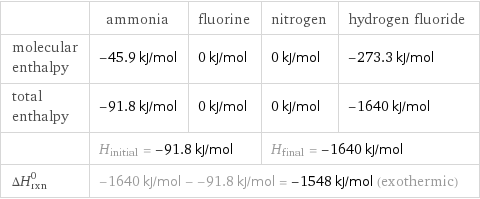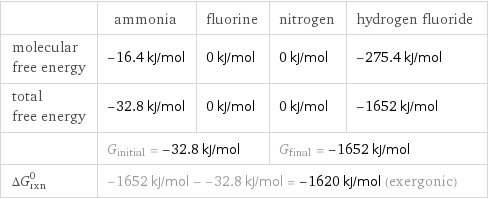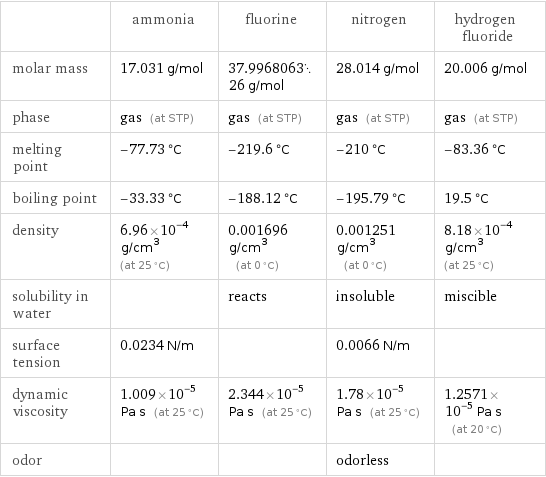Input interpretation

NH_3 ammonia + F_2 fluorine ⟶ N_2 nitrogen + HF hydrogen fluoride
Balanced equation

Balance the chemical equation algebraically: NH_3 + F_2 ⟶ N_2 + HF Add stoichiometric coefficients, c_i, to the reactants and products: c_1 NH_3 + c_2 F_2 ⟶ c_3 N_2 + c_4 HF Set the number of atoms in the reactants equal to the number of atoms in the products for H, N and F: H: | 3 c_1 = c_4 N: | c_1 = 2 c_3 F: | 2 c_2 = c_4 Since the coefficients are relative quantities and underdetermined, choose a coefficient to set arbitrarily. To keep the coefficients small, the arbitrary value is ordinarily one. For instance, set c_3 = 1 and solve the system of equations for the remaining coefficients: c_1 = 2 c_2 = 3 c_3 = 1 c_4 = 6 Substitute the coefficients into the chemical reaction to obtain the balanced equation: Answer: | | 2 NH_3 + 3 F_2 ⟶ N_2 + 6 HF
Structures

+ ⟶ +
Names

ammonia + fluorine ⟶ nitrogen + hydrogen fluoride
Reaction thermodynamics
Enthalpy

| ammonia | fluorine | nitrogen | hydrogen fluoride molecular enthalpy | -45.9 kJ/mol | 0 kJ/mol | 0 kJ/mol | -273.3 kJ/mol total enthalpy | -91.8 kJ/mol | 0 kJ/mol | 0 kJ/mol | -1640 kJ/mol | H_initial = -91.8 kJ/mol | | H_final = -1640 kJ/mol | ΔH_rxn^0 | -1640 kJ/mol - -91.8 kJ/mol = -1548 kJ/mol (exothermic) | | |
Gibbs free energy

| ammonia | fluorine | nitrogen | hydrogen fluoride molecular free energy | -16.4 kJ/mol | 0 kJ/mol | 0 kJ/mol | -275.4 kJ/mol total free energy | -32.8 kJ/mol | 0 kJ/mol | 0 kJ/mol | -1652 kJ/mol | G_initial = -32.8 kJ/mol | | G_final = -1652 kJ/mol | ΔG_rxn^0 | -1652 kJ/mol - -32.8 kJ/mol = -1620 kJ/mol (exergonic) | | |
Entropy

| ammonia | fluorine | nitrogen | hydrogen fluoride molecular entropy | 193 J/(mol K) | 202.8 J/(mol K) | 192 J/(mol K) | 173.8 J/(mol K) total entropy | 386 J/(mol K) | 608.4 J/(mol K) | 192 J/(mol K) | 1043 J/(mol K) | S_initial = 994.4 J/(mol K) | | S_final = 1235 J/(mol K) | ΔS_rxn^0 | 1235 J/(mol K) - 994.4 J/(mol K) = 240.4 J/(mol K) (endoentropic) | | |
Equilibrium constant
![Construct the equilibrium constant, K, expression for: NH_3 + F_2 ⟶ N_2 + HF Plan: • Balance the chemical equation. • Determine the stoichiometric numbers. • Assemble the activity expression for each chemical species. • Use the activity expressions to build the equilibrium constant expression. Write the balanced chemical equation: 2 NH_3 + 3 F_2 ⟶ N_2 + 6 HF Assign stoichiometric numbers, ν_i, using the stoichiometric coefficients, c_i, from the balanced chemical equation in the following manner: ν_i = -c_i for reactants and ν_i = c_i for products: chemical species | c_i | ν_i NH_3 | 2 | -2 F_2 | 3 | -3 N_2 | 1 | 1 HF | 6 | 6 Assemble the activity expressions accounting for the state of matter and ν_i: chemical species | c_i | ν_i | activity expression NH_3 | 2 | -2 | ([NH3])^(-2) F_2 | 3 | -3 | ([F2])^(-3) N_2 | 1 | 1 | [N2] HF | 6 | 6 | ([HF])^6 The equilibrium constant symbol in the concentration basis is: K_c Mulitply the activity expressions to arrive at the K_c expression: Answer: | | K_c = ([NH3])^(-2) ([F2])^(-3) [N2] ([HF])^6 = ([N2] ([HF])^6)/(([NH3])^2 ([F2])^3)](../image_source/734a5424568979d98490f790462284ba.png)
Construct the equilibrium constant, K, expression for: NH_3 + F_2 ⟶ N_2 + HF Plan: • Balance the chemical equation. • Determine the stoichiometric numbers. • Assemble the activity expression for each chemical species. • Use the activity expressions to build the equilibrium constant expression. Write the balanced chemical equation: 2 NH_3 + 3 F_2 ⟶ N_2 + 6 HF Assign stoichiometric numbers, ν_i, using the stoichiometric coefficients, c_i, from the balanced chemical equation in the following manner: ν_i = -c_i for reactants and ν_i = c_i for products: chemical species | c_i | ν_i NH_3 | 2 | -2 F_2 | 3 | -3 N_2 | 1 | 1 HF | 6 | 6 Assemble the activity expressions accounting for the state of matter and ν_i: chemical species | c_i | ν_i | activity expression NH_3 | 2 | -2 | ([NH3])^(-2) F_2 | 3 | -3 | ([F2])^(-3) N_2 | 1 | 1 | [N2] HF | 6 | 6 | ([HF])^6 The equilibrium constant symbol in the concentration basis is: K_c Mulitply the activity expressions to arrive at the K_c expression: Answer: | | K_c = ([NH3])^(-2) ([F2])^(-3) [N2] ([HF])^6 = ([N2] ([HF])^6)/(([NH3])^2 ([F2])^3)
Rate of reaction
![Construct the rate of reaction expression for: NH_3 + F_2 ⟶ N_2 + HF Plan: • Balance the chemical equation. • Determine the stoichiometric numbers. • Assemble the rate term for each chemical species. • Write the rate of reaction expression. Write the balanced chemical equation: 2 NH_3 + 3 F_2 ⟶ N_2 + 6 HF Assign stoichiometric numbers, ν_i, using the stoichiometric coefficients, c_i, from the balanced chemical equation in the following manner: ν_i = -c_i for reactants and ν_i = c_i for products: chemical species | c_i | ν_i NH_3 | 2 | -2 F_2 | 3 | -3 N_2 | 1 | 1 HF | 6 | 6 The rate term for each chemical species, B_i, is 1/ν_i(Δ[B_i])/(Δt) where [B_i] is the amount concentration and t is time: chemical species | c_i | ν_i | rate term NH_3 | 2 | -2 | -1/2 (Δ[NH3])/(Δt) F_2 | 3 | -3 | -1/3 (Δ[F2])/(Δt) N_2 | 1 | 1 | (Δ[N2])/(Δt) HF | 6 | 6 | 1/6 (Δ[HF])/(Δt) (for infinitesimal rate of change, replace Δ with d) Set the rate terms equal to each other to arrive at the rate expression: Answer: | | rate = -1/2 (Δ[NH3])/(Δt) = -1/3 (Δ[F2])/(Δt) = (Δ[N2])/(Δt) = 1/6 (Δ[HF])/(Δt) (assuming constant volume and no accumulation of intermediates or side products)](../image_source/bcb63047f4c2a3e74144a5bd8610c212.png)
Construct the rate of reaction expression for: NH_3 + F_2 ⟶ N_2 + HF Plan: • Balance the chemical equation. • Determine the stoichiometric numbers. • Assemble the rate term for each chemical species. • Write the rate of reaction expression. Write the balanced chemical equation: 2 NH_3 + 3 F_2 ⟶ N_2 + 6 HF Assign stoichiometric numbers, ν_i, using the stoichiometric coefficients, c_i, from the balanced chemical equation in the following manner: ν_i = -c_i for reactants and ν_i = c_i for products: chemical species | c_i | ν_i NH_3 | 2 | -2 F_2 | 3 | -3 N_2 | 1 | 1 HF | 6 | 6 The rate term for each chemical species, B_i, is 1/ν_i(Δ[B_i])/(Δt) where [B_i] is the amount concentration and t is time: chemical species | c_i | ν_i | rate term NH_3 | 2 | -2 | -1/2 (Δ[NH3])/(Δt) F_2 | 3 | -3 | -1/3 (Δ[F2])/(Δt) N_2 | 1 | 1 | (Δ[N2])/(Δt) HF | 6 | 6 | 1/6 (Δ[HF])/(Δt) (for infinitesimal rate of change, replace Δ with d) Set the rate terms equal to each other to arrive at the rate expression: Answer: | | rate = -1/2 (Δ[NH3])/(Δt) = -1/3 (Δ[F2])/(Δt) = (Δ[N2])/(Δt) = 1/6 (Δ[HF])/(Δt) (assuming constant volume and no accumulation of intermediates or side products)
Chemical names and formulas

| ammonia | fluorine | nitrogen | hydrogen fluoride formula | NH_3 | F_2 | N_2 | HF Hill formula | H_3N | F_2 | N_2 | FH name | ammonia | fluorine | nitrogen | hydrogen fluoride IUPAC name | ammonia | molecular fluorine | molecular nitrogen | hydrogen fluoride
Substance properties

| ammonia | fluorine | nitrogen | hydrogen fluoride molar mass | 17.031 g/mol | 37.996806326 g/mol | 28.014 g/mol | 20.006 g/mol phase | gas (at STP) | gas (at STP) | gas (at STP) | gas (at STP) melting point | -77.73 °C | -219.6 °C | -210 °C | -83.36 °C boiling point | -33.33 °C | -188.12 °C | -195.79 °C | 19.5 °C density | 6.96×10^-4 g/cm^3 (at 25 °C) | 0.001696 g/cm^3 (at 0 °C) | 0.001251 g/cm^3 (at 0 °C) | 8.18×10^-4 g/cm^3 (at 25 °C) solubility in water | | reacts | insoluble | miscible surface tension | 0.0234 N/m | | 0.0066 N/m | dynamic viscosity | 1.009×10^-5 Pa s (at 25 °C) | 2.344×10^-5 Pa s (at 25 °C) | 1.78×10^-5 Pa s (at 25 °C) | 1.2571×10^-5 Pa s (at 20 °C) odor | | | odorless |
Units
